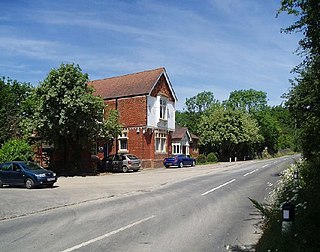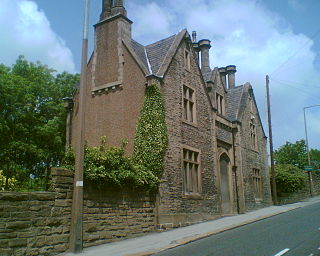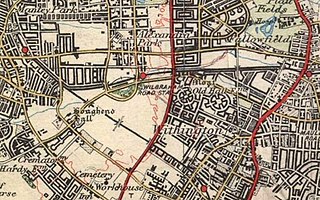Related Research Articles

Ardingly was a railway station which served the West Sussex village of Ardingly in England. It was opened on 3 September 1883 by the London, Brighton and South Coast Railway (LBSCR) closed eighty years later and is currently used as an aggregates depot. The Bluebell Railway owns the trackbed from just east of the station to Horsted Keynes and has long-term plans to rebuild the line.
The Sheffield District Rail Rationalisation Plan was a series of linked railway civil engineering projects, station and line closures and train route changes that took place in and around Sheffield, South Yorkshire. The majority of these changes took place in the 1960s and early 1970s, however the plan, by now much modified in the face of rapidly dwindling freight traffic, was not fully realised until the 1980s.

Dudley Railway Station was a railway station in Dudley, West Midlands, England, built where the Oxford-Worcester-Wolverhampton Line and the South Staffordshire Line diverged to Wolverhampton and Walsall and Lichfield respectively.

Fallowfield railway station is a disused station that is located on Wilmslow Road in Fallowfield, a southern suburb of Manchester, England. It was on the Fallowfield Loop railway line, a suburban railway which looped around the south of the city and terminated at the former Manchester Central railway station. The station closed to passengers in 1958, but its building still stands on the corner of Wilmslow Road and Ladybarn Road.

The Devon and Somerset Railway (D&SR) was a cross-country line that connected Barnstaple in Devon, England, to the network of the Bristol and Exeter Railway (B&ER) near Taunton. It was opened in stages between 1871 and 1873 and closed in 1966. It served a mostly rural area although it carried some through services from east of Taunton to the seaside resort of Ilfracombe.

Hyde Road was a railway station in Gorton, Manchester, England, on the Fallowfield Loop Line. It opened in 1892 and closed in 1958, when local passenger services on the line were withdrawn. The station was sometimes advertised as Hyde Road for Belle Vue, given its close proximity to Belle Vue Zoo which was about one mile away. The line was closed completely in 1988 and the track was taken up. The station has long since been demolished and the site was partly redeveloped. The former trackbed is now a popular shared use path called the Fallowfield Loop.

The Holmfirth branch line is a disused railway line that ran for 2 miles (3.2 km) from Brockholes to Holmfirth, in West Yorkshire, England. The line was built as double track as there were plans to extend the line up the Holme Valley.
There are 22 disused railway stations in the 75 miles (121 km) between Bristol Temple Meads and Exeter St Davids, 12 of which have structures that can still be seen from passing trains. Most were closed in the 1960s but four of them, especially around Weston-super-Mare, were replaced by stations on new sites. 13 stations remain open on the line today, but there have been proposals to reopen stations at Cullompton and Wellington.

Wilbraham Road railway station was in Whalley Range, Manchester, England, on the Fallowfield Loop line between Manchester Central and Fairfield, via Chorlton. Opened as Alexandra Park in 1892 by the Manchester, Sheffield and Lincolnshire Railway, it was near the junction of Alexandra Road South and Mauldeth Road West, close to Alexandra Park, and served the expanding residential suburb of Whalley Range. The railway line has since been converted into a shared use path.

Selsdon railway station was at the junction of the Croydon, Oxted and East Grinstead Railway and the now-closed Woodside and South Croydon Joint Railway. Opened in 1885 as "Selsdon Road" and it was 2 miles (3.2 km) from Selsdon village.
Honor Oak railway station was a station opened in December 1865 in Honor Oak, London by the London, Chatham and Dover Railway on the Crystal Palace and South London Junction Railway. The line was built to carry passengers to The Crystal Palace after its move from Hyde Park. The station featured two wooden platforms, and apart from two brief closures during World War I and World War II, it remained open until 1954 when the entire branch line was closed. The station was demolished around 1956–7 and afterwards the site has been redeveloped with housing.
Kingthorpe railway station was a railway station that served the village of Kingthorpe, Lincolnshire, England between 1874 and 1956, on the Louth to Bardney line.

Pill railway station was a railway station on the Portishead Branch Line, 7.8 miles (12.6 km) west of Bristol Temple Meads, serving the village of Pill in North Somerset, England. The station was opened by the Bristol and Portishead Pier and Railway Company on 18 April 1867. It had two platforms, on either side of a passing loop, with a goods yard and signal box later additions. Services increased until the 1930s, at which point a half-hourly service operated. However the Portishead Branch was recommended for closure by the Beeching report, and the station was closed on 7 September 1964, although the line saw freight traffic until 1981. Regular freight trains through the station began to run again in 2002 when Royal Portbury Dock was connected to the rail network.

Morecambe Euston Road was the terminus station of the London and North Western Railway's branch line to Morecambe, in Lancashire, England. It closed in 1962, after which all trains to Morecambe used the nearby Morecambe Promenade station.

The Evesham branch line is a mostly disused English railway line running from Barnt Green via Redditch, Alcester and Evesham to Ashchurch. It was sometimes known as the Gloucester loop line of the Midland Railway.

Speech House Road railway station is a disused railway station opened by the former Severn and Wye Railway in 1875, it remained open for 88 years until the line, north of Parkend, closed to freight in 1963. Passenger trains on the Severn and Wye Railway, north of Lydney, were withdrawn from 1929.

Ferryhill was a railway station located in Ferryhill in County Durham, Northeast England. It was located on what became the East Coast Main Line between Darlington and Durham, close to the junctions with several former branches, including the extant freight-only Stillington Line to Norton-on-Tees and Stockton.

Scholes railway station was a station in Scholes, Leeds, West Yorkshire, England, on the Cross Gates–Wetherby line. It opened on 1 May 1876 and closed on 6 January 1964. The former station building is now a restaurant, which from 1984 to 1999 used a Mk 1 railway carriage as extra rooms. The latter is now restored and in use on the Keighley and Worth Valley Railway.

Thorner railway station was a station in Thorner, West Yorkshire, England, on the Cross Gates–Wetherby line. It opened on 1 May 1876 and closed on 6 January 1964. It served Thorner village immediately south of the station as well as the village of Scarcroft a mile to the west. The station was originally called Thorner & Scarcroft, in 1885 it was renamed into Scarcroft for some time before reverting to the old name, and in 1901 the name was finally shortened to Thorner.

Eddleston railway station served the village of Eddleston, Scottish Borders, Scotland from 1855 to 1962 on the Peebles Railway.
References
- ↑ Catford, Nick; Lambeth, Roy. "Station Name: Uffculme". Disused Stations Cite Record. Retrieved 2 July 2016.
- 1 2 3 "Uffculme Station". Disused Stations. Retrieved 7 November 2015.